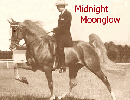| | | |
In 1737, in the hill country of Tennessee, an obscure nondescript piebald horse called Bald Stockings did a smooth, single-footing gait that came to be known as a 'running walk'. However, a long time before that, (in fact about 5 million years before that), tiny, three-toed Pliocene horses left footprints in the mud of Tanzania. A subsequent analysis of the fossilized footprints reveals that these Hipparion horses travelled at a good clip of 15 kilometres per hour, utilizing this same gait. This finding provides evidence that the running walk is an instinctive and natural gait, that has been around genetically since pre-Historic times.
The early settlers of the Middle Basin of Tennessee who came from Virginia, the Carolinas and other surrounding states, bred fine Thoroughbreds, Standardbreds, Morgans, American Saddlebreds, Narragansett Pacers, and Canadian Pacers. They used their horses for all day riding on plantations, and as transportation for the whole family, and they needed as smooth and non-tiring a ride as possible. | Click on the thumbnails below to read more about these breeds. |  |  |  |  |  |  | By combining the traits and gaits of these great horse families, the foundation was laid for a horse who developed distinctive qualities of its own, resulting in one of the greatest breeds of pleasure, show and trail riding horses - the Tennessee Walking Horse. In 1885, a cross between a stallion called Allendorf, from the Hambletonian family of trotters, and Maggie Marshall, a Morgan mare, produced Black Allan. He was a black colt with a white blaze, off hind coronet and near hind sock, foaled in 1886. He was later to be chosen by the Tennessee Walking Horse Breeders Association as the foundation sire of the Tennessee Walking Horse breed and designated as Allan F-1. The war Between the States occasioned the crossbreeding of the Confederate Pacers and Union Trotters, producing the Southern Plantation Walking Horse or Tennessee Pacer. While the bloodlines of the Gray Johns, Copperbottoms, Mountain Slashers, Tom Hal Racers, Pacing Pilots, Travellers, Brooks and Bullett families produced the Tennessee pacer, it was a cross between Allan F-1 and the Tennessee Pacer that produced today's Tennessee Walking Horse. | The stallion who was chosen as the foundation sire of the Tennessee Walking Horse,
when the registry was formed in 1935, was Allan F-1. This black stallion's ancestry was a
mixture of Morgan blood, and Hambletonian, who was the founding sire of the Standardbred.
Allan was considered the greatest contributor to the Walking Horse breed.
|
Mainly used for utility and riding stock, the breed gained wide popularity for its ease of gait, and ability to stride faultlessly over the hills and valleys of the rocky middle Tennessee terrain. Being used for all types of farm work, as well as family transportation and recreation, the old plantation-type horse was not trained for showing in those days -- its gait was naturally inherited.
| Click on the thumbnail for an extended
Pictorial History of the Tennessee Walking Horse
 |
| | | |

